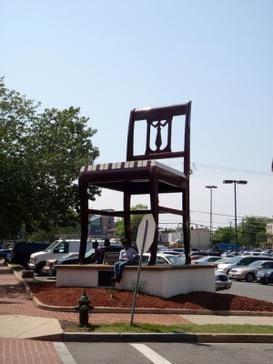Artist Bassett Furniture Location Washington, D.C. Created 1959 | Type sculpture Owner Curtis Investments Year 1959 | |
 | ||
Dimensions 590 cm × 370 cm (234 in × 144 in) Similar Broken Chair, House, Panton Chair, Zig‑Zag Chair, Red and Blue Chair | ||
Heirloom quality eco ergonomic chair sculpture by gustaf rooth
Chair is a public artwork designed as an advertisement by Bassett Furniture, located at the intersection of Martin Luther King Ave. and V. Street S.E., in the Anacostia neighborhood of Washington, D.C., United States of America. Chair was originally surveyed as part of the Smithsonian's Save Outdoor Sculpture! survey in 1994. It was once considered the world's largest chair, but has been overtaken by works like Broken Chair in Geneva and the temporary The Writer on Hampstead Heath in London.
Contents
- Heirloom quality eco ergonomic chair sculpture by gustaf rooth
- Natanel gluska fast forward chairs sculptures making of the long 8 chair
- Description
- Acquisition
- Re dedication
- Looking Glass House
- Community reception
- References
Natanel gluska fast forward chairs sculptures making of the long 8 chair
Description
The chair, which stands 19 1/2 feet high, is a detail-to-detail replica of a Duncan Phyfe style chair. Painted brown with a white and brown striped "cushion", the chair is entirely made of aluminum. Weighing between 4,000 and 4,600 pounds, the chair sits on a concrete base.
Acquisition
The chair was built in 1959 by Virginia-based furniture maker Bassett Furniture. The concept for the chair came from Charles Curtis, of the Curtis Brothers Furniture company, as a clever way to bring customers to their family showroom which was located on the grounds where the chair is currently placed.
The piece was dedicated on July 11, 1959, and a plaque was placed with it, stating:
THE WORLD'S LARGEST CHAIRPRESENTED TOCURTIS BROS.FOR THEIR OUTSTANDING LEADERSHIPAND SERVICE TO THE PUBLIC/BY THEBASSETT FURNITURE INDUSTRIES.THE CHAIR MADE OF SOUND HONDURAS MAHOGANYIS 19 1/2 FEET TALL AND WEIGHS 4000 POUNDSDEDICATED JULY 11, 1959DESIGNEDLEO M. HIRAMETTBUILT BY J. E. BASSETT, JR.Re-dedication
John Kidwell, the caretaker of the Chair, frequently patched holes that would form after heavy rains with cement. During the days of August 23–24, 2005, the original Chair was disassembled by a backhoe and taken away for restoration. Made entirely of Honduras Mahogany, the legs had begun to rot. On April 25, 2006, the chair was returned by Curtis Properties (was Curtis Brothers), however, this was a new chair, made entirely of brown aluminum. Over 250 people attended the re-dedication including Mayor Anthony A. Williams.
With the dedication of a new chair, a new plaque was placed, reading:
THE BIG CHAIRRE-DEDICATION APRIL 25, 2006THIS COMMUNITY LANDMARK REPRESENTS THE CURTIS COMPANIESLONG-STANDING ALLEGIANCE TO THE NEIGHBORHOOD ANDSTEADFAST COMMITMENT TO UNITY, PROSPERITY, AND GOOD WILLTO ALL WASHINGTONIANS AND FRIENDS OF ANACOSTIA.This new chair was designed by Devery Lomax managed by John Kidwell. It was fabricated by Cinnbar, an Orlando-based business known for their oversized objects, and Nelson's Welding. The new chair cost over $40,000 to build. Upon its delivery, by flatbed truck, overpasses had to be avoided due to the size of the chair.
Looking Glass House
On August 13, 1960, Rebecca Kirby (aka Lynn Arnold) moved "onto" the chair. A 10-by-10-foot cubicle was built and placed on the seat, furnished with a shower, bed, toilet, heater, air conditioner and balcony. Placed upon the chair by way of forklift, Kirby lived in the chair for 42 days. In the cubicle, she would watch TV, read books, and talk on the telephone, as well as dine, as her meals were delivered every day.
Kirby would step outside onto the balcony every few hours to greet visitors who learned about her living situation due to newspapers advertising her as "Alice in the Looking Glass House". Visitors would be encouraged to guess how long she'd maintain her residency. Her then 14-month-old son, Richard, visited often, being placed in a dumb waiter and sent up to see her.
After 42 days, Kirby "decided to return to earth," earning $1,500 for her stay.
Community reception
The Chair has been received as a part of neighborhood life since its original installation. Anacostia, a neighborhood that has seen economic and cultural ups and downs prides itself on a landmark that withstands the community's evolution.
The Chair is often used as a geographic marker for direction giving and holiday celebration; Santa Claus sits upon the chair during Christmas. When the Chair was reinstalled in 2006, community members surrounded the giant, clapping, yelling and photographing the new chair.
During the 1968 Washington, D.C. riots the Chair was one of the few landmarks to go unscathed in a neighborhood heavily affected by Martin Luther King, Jr.'s death.
